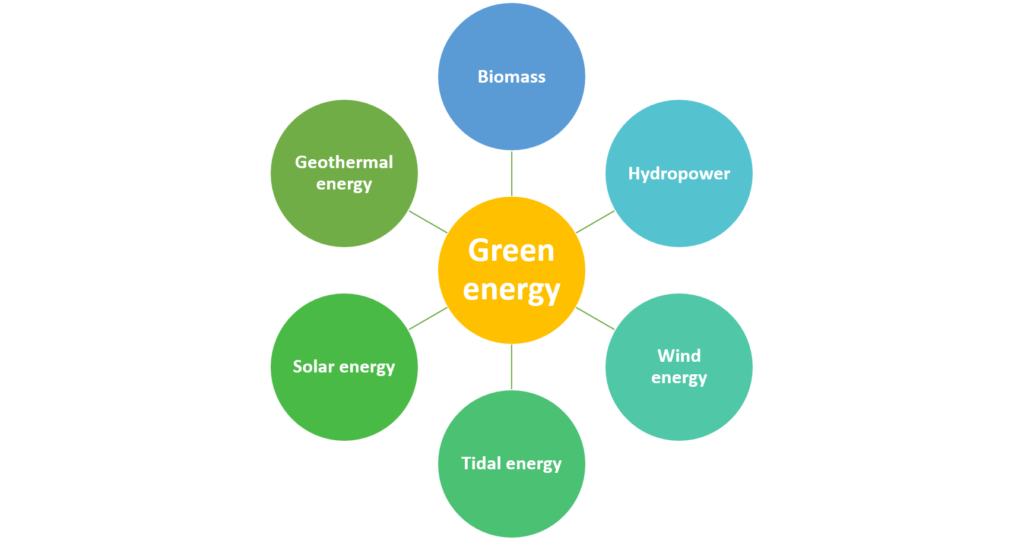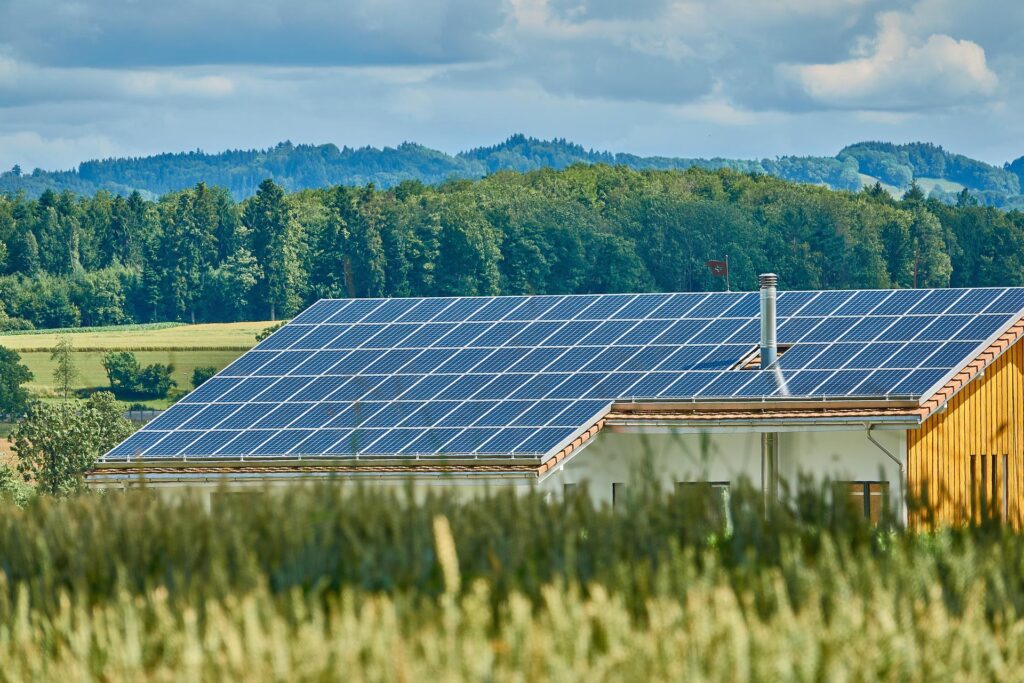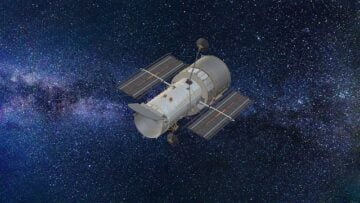Green energy is the ultimate solution to maintain the ecological balance on this planet. Recently, it has become a buzzword because of its ability to replace fossil fuels and coal. As the green color signifies renewal, green energy indicates renewal power.
Almost all sectors need energy for sustainable development. Historically, fossil fuels were the primary energy source, but presently, their existence is at risk. They also impact human health and the environment by producing hazardous elements. Hence, the demand for clean or green energy is skyrocketing.
What is green energy?
Green energy, also known as renewable energy, is the fuel acquired from natural resources such as the sun, tides, wind, etc. These resources are clean, abundant, and indefinite. A few examples include geothermal, solar, biomass, hydropower, wind energy, and many others. This energy does not produce any carbon emissions and hence is eco-friendly. Below are the top five preliminary sources to obtain it:
- The sun
- Chemical reactions from minerals
- Nuclear reaction induced by humans
- Geothermal energy
- Gravitational and motion potential of the moon and Earth
These sources can be categorized into three parts:
- Photon methods like photosynthesis, photochemistry, and photovoltaic conversion.
- Sources of heat, such as biomass combustion and solar collectors.
- Mechanical reserves namely hydro, wind, wave, and tidal power.
Many companies are already using green energy for power generation. For instance, Google, Walmart, Intel, Cisco, etc. There will soon be a massive need for renewables to charge Electric Vehicles. China is currently the biggest investor in renewables in the world.
Also read, the core of self-driving car technology.
Types of green energy

Hydropower
It is one of the most established sources of electricity for commercial applications. It uses the natural flow of moving water to produce power. This type accounts for almost 20% of global electricity generation. Generally, hydroelectric installations and plants last longer with routine maintenance. Turbines stay active for about fifty years, dams for a hundred years, and waterways for a thousand years with slight renovation. This is because of the continual, steady operation without excessive heat or other stress. Due to the rapid response time of hydro turbines, they can supply both peak and base load demands.
Adverse environmental conditions including corrosion of turbine blades in certain situations, social effects such as shifting people from the reservoir zone, and moderately high capital costs when compared with fossil fuel plants can affect hydropower. In terms of hydroelectricity production, China leads the world.
Wind energy
Wind turbine generators extract power from the wind and use it to create electricity. Countries like the USA, Europe, and India have installed wind power generating stations on a large scale. Wind turbines are available in different structures: horizontal axis, vertical axis, and concentrators. The capacity of each structure is determined by axial forces, drag, and torque. Its efficiency depends on wind speed, direction, the height of the system, and the probability of environmental influences. Wind farms, individual machines, and integrated systems are some widely established forms of collecting wind energy.
The wind power capacity is growing, which leads to the reduction of carbon and other emissions. This results in improved technology and declining adverse effects each day. The Global wind energy council has stated that wind energy only accounts for a few % of the world’s energy requirements. This industry must expand exponentially to accommodate a large share of the population. Vestas is the largest manufacturer, seller, installation, and service provider of wind turbines.
Green energy using biofuels and biomass
Biomass comprises residues and wastes of animals and plants. It releases heat by reacting with oxygen in the metabolic and combustion process. This heat, usually more than 400℃ produces electricity. Initially, a material can be transformed into biofuel by combining chemical and biological methods. Then, it is processed into a useful form, mainly liquid fuels for transportation. Fuels such as methane gas, methyl esters, liquid ethanol, solid charcoal, and oils are biofuels.
Biofuels and biomass are collectively known as bioenergy.
Biomass is classified into three types:
- Biochemical: This includes aerobic digestion, anaerobic digestion, biophotolysis, and alcohol fermentation.
- Thermochemical: Direct combustion, pyrolysis, and other thermochemical methods constitute thermochemical reactions.
- Agrochemical: This involves biodiesel esterification and fuel extraction.
According to estimates, biofuels are expected to meet over 25% of the global transportation fuel demand by 2050. In the United States, the Renewable Energy Group (REG) is the largest biodiesel producer.
Solar energy
Solar radiation plays a crucial role in developing solar energy. It acts as an input to solar devices and generates power. Solar heating has a broad scope in the domestic, heating buildings, drying crops, heat engines, and transportation applications. A few commercially used devices are solar panels, heaters, cookers, air conditioners, inverters, etc.
In photovoltaics, positive and negative charge carriers are separated by electromagnetic radiation. With the presence of an electric field, these charges can produce power for external circuits. These electrostatic fields are permanently present at junctions or inhomogeneities, providing the electromotive force (EMF) required for converting light into electricity.
The process of converting sunlight into electricity is either by direct photovoltaics (PVs), indirect concentrators, or by using both at the same time. Using the photovoltaic effect, solar cells develop electricity. Solar power systems concentrate radiant energy into a single spot, often to drive a steam turbine. Solar power has been used for so long, from calculators with a single solar cell to remote homes with an off-grid rooftop PV system.
In the 1980s, concentrated solar power plants were designed for commercial use. Due to the lower costs of solar electricity costs, grid-connected solar PV systems are gaining exponential popularity. There are millions of installations and gigawatt-scale photovoltaic power stations, and more are getting built. Utility-scale solar, along with onshore wind, achieved 4% of the world’s electrical power by 2021.

Did you know that the pyramids of Gizza are surrounded by solar panels? This place offers endless opportunities to generate electricity.
Tidal energy
The rising and falling water level in an ocean is known as a tide. This can be diurnal (day) and semi-diurnal (half-day). The motion of water produces tidal currents that may have high speeds. The tidal power forms by trapping the high tide in an area behind the dam. The potential of tidal power is specified by the range (difference between high and low tide). The sites are characterized by the range, flow, and periodicity of tides in coastal areas.
With a capacity of 254 megawatts (MW), Sihwa Lake Tidal Power Station in South Korea is the largest electricity generator in the world.
Geothermal energy
Basically, it’s a type of thermal energy induced and stored inside the Earth. Throughout history, it has been utilized for bathing, heating, and cooking. As the core of the Earth reaches 4,000°C, geothermal energy forms through radioactive decay. Globally, geothermal energy is abundant, but its use depends on the region.
Currently, the USA is the largest producer of geothermal energy.
In many areas, renewable energy has become one of the most competitive resources due to rapid technological advancements and low costs. Today, almost 100 cities in the world are using approximately 70% of green energy. This figure will rise significantly with the smart city boom. The number of capacity installations is high despite supply chain constraints, more shipping costs, and expensive critical commodities. In addition to increasing renewable portfolio standards and mandating energy storage procurement, many cities and utilities have set ambitious clean energy objectives.
A fast-growing market for renewables is poised to appear in 2022 as concern over climate change and support for environmental, social, and governance factors grow. As a result, demand for cleaner energy sources is rising across most market segments.
On the whole, these green alternatives will revolutionize the world very soon.




Interesting post… I recommended one of my relative.. He is in 9th standard. He found this very informative and brilliant
Thank you so much!
[…] deal with this challenge, adopting green energy resources would be helpful for maintaining the ecological […]
[…] resources due to the increasing threat of natural sources depletion. Despite rapid progress in renewable energy, cosmic ventures hold a special place to cater to the demand of future […]
Thanks for your blog, nice to read. Do not stop.
Thank you so much, Mark! Keep reading!